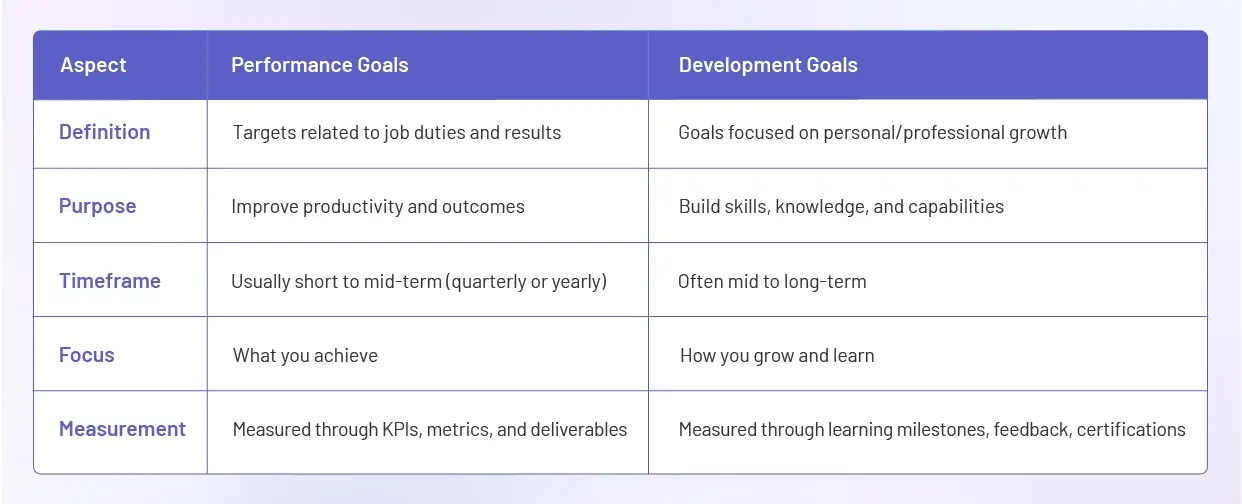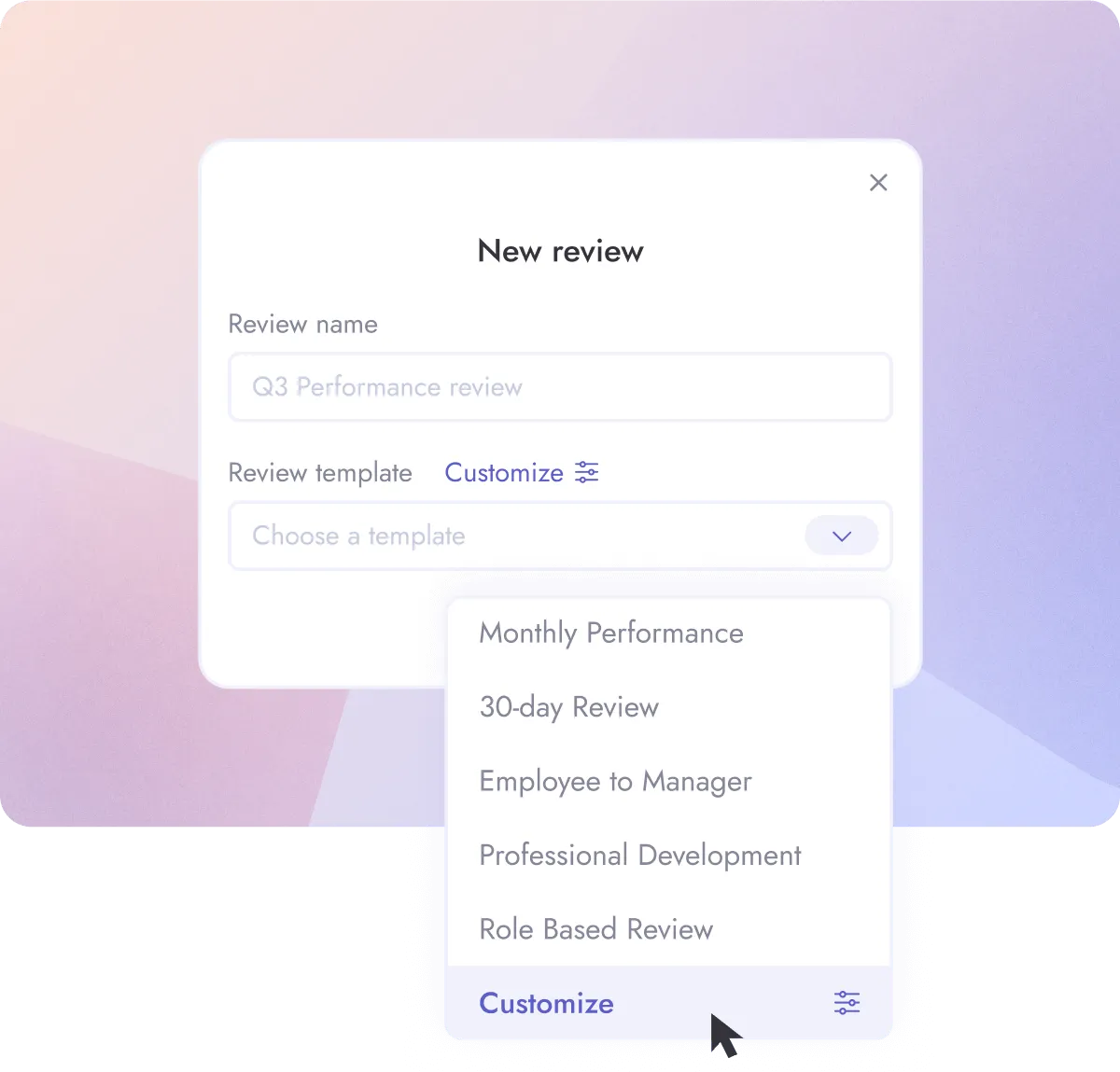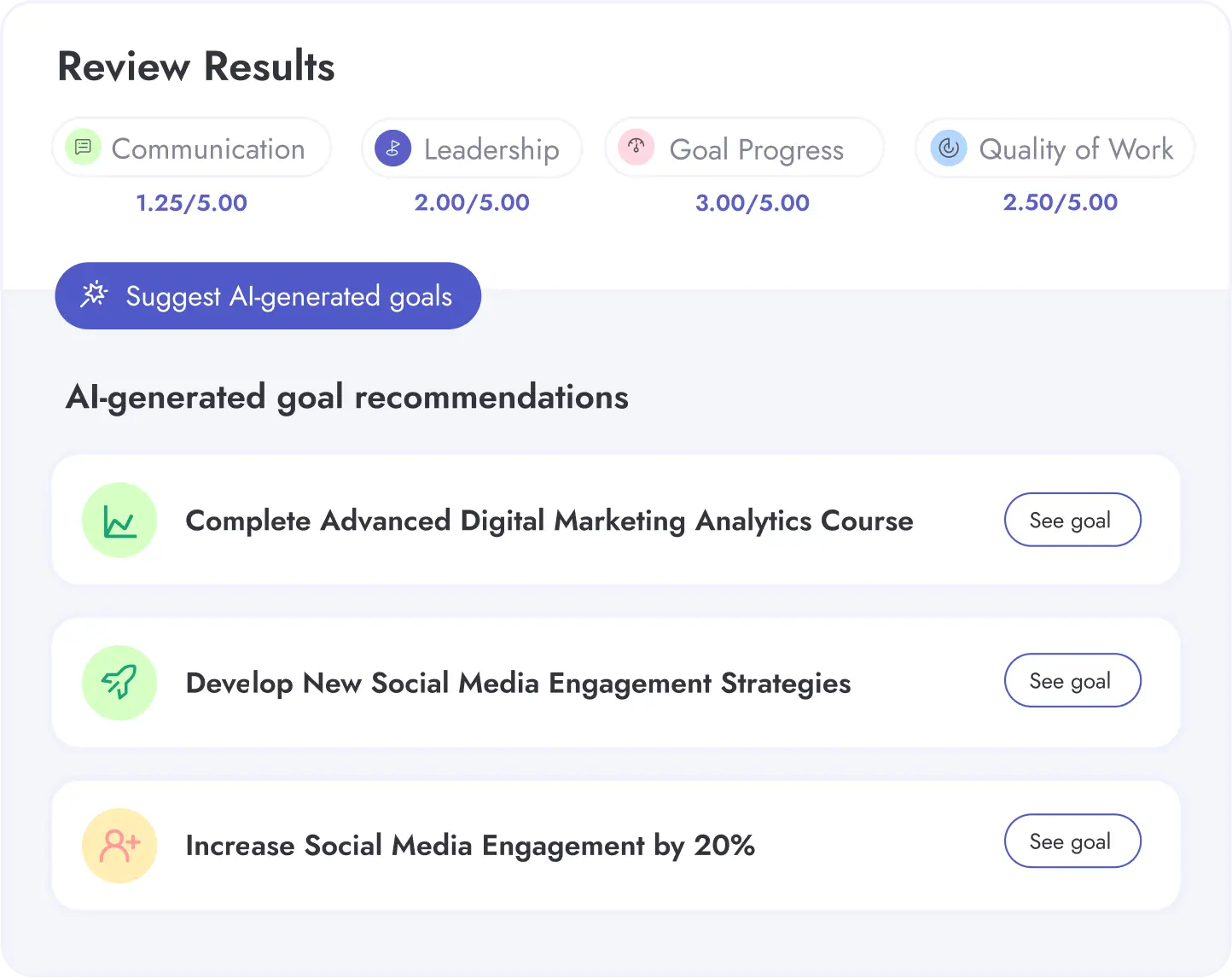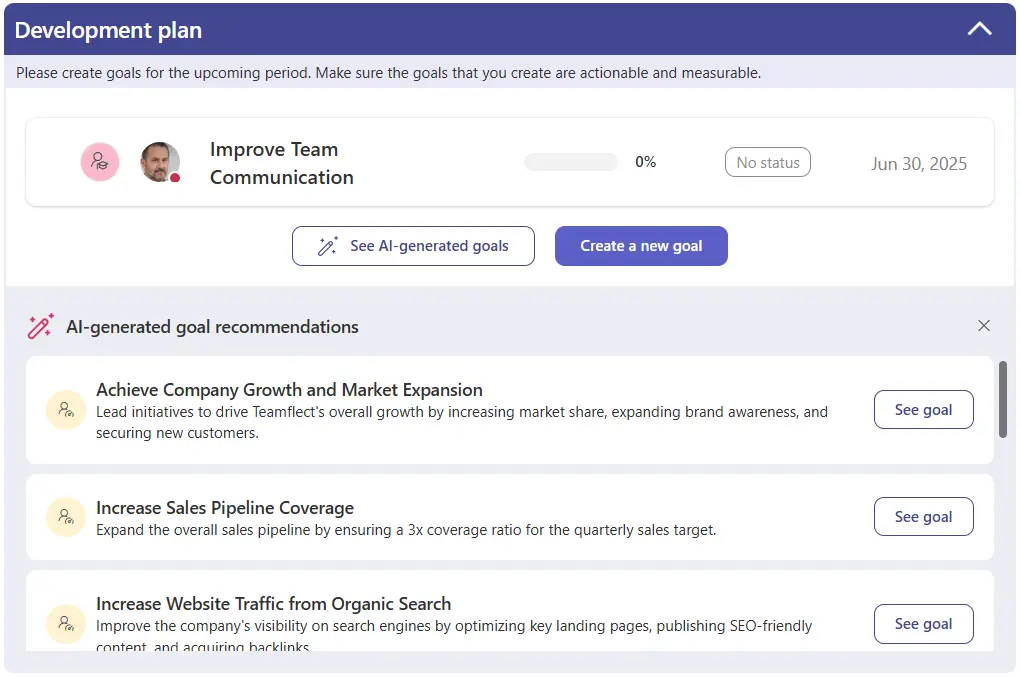Get the Ebook
.svg)
The end of the quarter is fast approaching and you know what that means!
Performance review goals!
For the reviewees, this means that all those quarterly performance review goals are coming up!
For people leaders, it means the time to set some new quarterly performance review goals.
Of course, not every organization needs to follow the same performance review frequency.
That is why in this article we included performance review examples such as:
Finding review goal examples may not be enough. In this article, we will also show you how you can integrate the goals you set in the review period, into your performance review templates. All you have to do is to keep scrolling!
Performance review goals are a crucial part of talent development and a company's overall business success strategies. Because without clear goals guiding your workforce, especially goals created from performance review results where individual contributions are evaluated, it is very hard to set yourself up for success in the long run.
These goals also serve as a foundation for constructive feedback during reviews, helping managers evaluate progress, recognize achievements, and identify areas for improvement.

Performance goals specifically focus on achieving specific results in relation to an employee's current responsibilities. For example, a performance goals could be to increase sales by 10% within a certain amount of time.
Development goals on the other hand are more so about an individual's career, effecting their professional journey as a whole. These growth focused goals can be learning a new software or attending leadership training. Ultimately they are all about improving existing skills or gaining new knowledge.
The most important thing to consider while setting performance review goals is to make sure those goals are aligned with your organizational strategy.
The best way to ensure goal alignment in performance review goals is to use the SMART criteria while setting your goals.
A performance review goal that fits the SMART goal criteria has to be:
Specific: Goals should be clear and specific to avoid ambiguity.
Measurable: Define Metrics! Each goal should have clear metrics or indicators for measuring progress and achievement.
Achievable: Set goals that are challenging yet achievable. Unrealistic goals can demotivate employees, while too-easy goals may not push them to perform at their best.
Relevant: Goals should be relevant to the employee’s role and responsibilities. They should also consider the employee’s career aspirations and personal development plans.
Time-Bound: Each goal should have a clear timeline or deadline.

Making performance review goals smart comes down to following the SMART goal criteria which simply put is all about making your objectives;
Follow this schema and your goals will be just fine!
Below are five examples of quarterly performance review goals when you utilize an employee development system. Quarterly performance review goals have a more short-term emphasis when compared to mid-year and annual goal examples. They can, however, also serve as sub-goals or goal checkpoints in the longer-term goals.
All of these goals were mapped out specifically to fit the SMART goals criteria. With each goal, we will also go over why that goal happens to be “SMART”.
Quarterly Goal Example 1: Increase Customer Satisfaction Scores
Aim to increase customer satisfaction scores by 10% by the end of the quarter through enhanced service protocols and staff training.
What makes it a SMART goal?
This goal is specific to customer service, measurable via scores, achievable with focused efforts, relevant to business success, and time-bound within the quarter.
Quarterly Goal Example 2: Reduce Project Delivery Times
Target a 15% reduction in average project delivery times by streamlining processes and implementing agile methodologies within the next three months.
What makes it a SMART goal?
This goal focuses on efficiency, is measurable through delivery times, is achievable with process improvements, is relevant to operational success, and is confined to the quarterly timeline.
Quarterly Goal Example 3: Enhance Team Skill Set
Commit to upskilling the team by having each member complete a relevant professional development course by quarter-end.
What makes it a SMART goal?
This goal is specific to skill enhancement, measurable by course completion, achievable with scheduled training, relevant to team capability, and time-bound within the quarter.
Quarterly Goal Example 4: Improve Internal Communication
Launch and adopt a new internal communication tool aiming for at least 90% staff engagement rate by the quarter’s end to foster better collaboration and information sharing.
What makes it a SMART goal?
This goal is specific to communication improvement, measurable by engagement rates, achievable with the right tool and encouragement, relevant to operational efficiency, and time-bound.
Quarterly Goal Example 5: Boost Sales Figures
Increase sales figures by 20% over the next quarter through strategic marketing campaigns and expanding the sales team.
What makes it a SMART goal?
This goal is specific to sales performance, measurable by sales data, achievable with targeted efforts, relevant to business growth, and time-bound to the quarterly review period.

Mid-year performance reviews serve as a halfway checkpoint for the fiscal year. Mid-year review goals are set more ambitiously than quarterly performance review goals.
Mid Year Goal Example 1: Expand Market Reach
Aim to enter two new geographic markets by the mid-year, leveraging market research and targeted marketing strategies.
What makes it a SMART goal?
This goal is specific to market expansion, measurable by entry into new markets, achievable with focused market analysis and strategy implementation, relevant to business growth, and time-bound by the mid-year checkpoint.
Mid Year Goal Example 2: Increase Product Line
Develop and launch a new product line by the mid-year review, based on customer feedback and market demand analysis.
What makes it a SMART goal?
This goal is specific to product development, measurable by the successful launch of the new line, achievable with dedicated resources, relevant to meeting customer needs, and time-bound to the mid-year timeline.
Mid Year Goal Example 3: Improve Operational Efficiency
Reduce operational costs by 10% by the mid-year through process optimization and waste reduction initiatives.
What makes it a SMART goal?
This goal is specific to cost reduction, measurable by expense records, achievable with efficiency improvements, relevant to financial health, and time-bound to the mid-year mark.
Mid Year Goal Example 4: Enhance Employee Satisfaction
Increase employee satisfaction scores by 15% by conducting monthly feedback sessions and implementing at least two major feedback points by the mid-year.
What makes it a SMART goal?
This goal is specific to employee engagement, measurable by satisfaction surveys, achievable with responsive actions, relevant to organizational culture, and time-bound.
Mid Year Goal Example 5: Strengthen Leadership Skills
For leadership roles, complete a leadership development program and mentor two junior employees by the mid-year.
What makes it a SMART goal?
This goal is specific to leadership development, measurable by program completion and mentorship, achievable with commitment, relevant to personal and organizational growth, and time-bound by the mid-year review.

Annual performance review goals are perhaps the most ambitious of all the goal examples in this article. These goals being ambitious, however, shouldn’t be the only criteria.
Annual review goals should be able to be divided into multiple checkpoints that can be visited throughout the year in order to make sure they stay visible and relevant in the long term.
They can also be structured in a way that quarterly and mid-year performance review goals serve as subgoals that form their completion criteria. So let's take a look at some examples of long term goals for performance reviews!
Annual Goal Example 1: Achieve Revenue Targets
Increase annual revenue by 25% through strategic client acquisition and retention efforts.
What makes it a SMART goal?
This goal is specific to revenue growth, measurable by financial performance, achievable with an aggressive sales and marketing strategy, relevant to the company’s overall success, and time-bound within the fiscal year.
Annual Goal Example 2: Complete Major Project
Successfully complete the flagship project by year-end, meeting all predefined milestones and staying within the budget.
What makes it a SMART goal?
This goal is specific to project management, measurable by project milestones and budget adherence, achievable with effective project oversight, relevant to company objectives, and time-bound to the annual cycle.
Annual Goal Example 3: Corporate Social Responsibility Initiative
Launch and sustain a CSR initiative that aligns with company values and achieves at least 80% employee participation by year-end.
What makes it a SMART goal?
This goal is specific to social responsibility, measurable by participation rates, achievable with engaging initiatives, relevant to company ethos, and time-bound within the year.
Annual Goal Example 4: Customer Base Growth
Grow the customer base by 30% by the end of the year through new acquisition channels and improving customer retention rates.
What makes it a SMART goal?
This goal is specific to customer growth, measurable by customer data, achievable with marketing and service improvements, relevant to business expansion, and time-bound to the year-end.
Annual Goal Example 5: Professional Development for Staff
Implement a comprehensive professional development program for all staff, aiming for 100% participation and at least one completed course per employee by year-end.
What makes it a SMART goal?
This goal is specific to staff development, measurable by participation and course completion, achievable with a structured program, relevant to enhancing capabilities, and time-bound within the annual review cycle.
Leadership goals are crucial to ensure that your performance reviews are effective and help create the right workplace by setting the right example for everyone. So let's take a look at a couple examples of the type of leadership goals you can set.
Leadership Goal Example 1: Improve Team Productivity
Implement a new task management system and increase team output by 15% by the end of Q2.
What makes it a SMART goal?
It is specific to productivity improvement, measurable by output increase, achievable through process improvements, relevant to leadership responsibilities, and time-bound to the end of Q2.
Leadership Goal Example 2: Strengthen Team Engagement
Conduct monthly 1-on-1 check-ins with all direct reports through June to boost morale and retention.
What makes it a SMART goal?
This goal is specific (monthly 1-on-1s), measurable by number of check-ins, achievable with calendar management, relevant to leadership and culture, and time-bound through June.
Leadership Goal Example 3: Develop Future Leaders
Identify and mentor two high-potential team members for leadership readiness by July.
What makes it a SMART goal?
It’s specific to mentoring, measurable by the number of mentees, achievable through regular coaching, relevant to succession planning, and time-bound to July.
Leadership Goal Example 4: Enhance Cross-Team Collaboration
Host two cross-functional team workshops before August to improve interdepartmental communication.
What makes it a SMART goal?
It specifies collaboration, is measurable by workshop count, achievable with planning, relevant to team efficiency, and time-bound by August.
Leadership Goal Example 5: Reduce Employee Turnover
Lower team turnover by 10% by end of Q2 through feedback sessions and recognition programs.
What makes it a SMART goal?
This is specific to turnover reduction, measurable by turnover rate, achievable through action plans, relevant to team stability, and time-bound by Q2.
Performance reviews are the perfect time to discuss career objectives and aspirations. And the perfect time to plan out accordingly. So let's take a look at what kind of career goals you can set so you can take some inspiration or simply gain a better understanding.
Career Goal Example 1: Obtain a Professional Certification
Earn a project management certification (e.g., PMP or PRINCE2) by July to expand leadership potential.
What makes it a SMART goal?
It’s specific to certification, measurable by completion, achievable with study, relevant to professional development, and time-bound to July.
Career Goal Example 2: Improve Public Speaking Skills
Deliver two internal presentations by mid-year to build confidence and clarity in communication.
What makes it a SMART goal?
This goal is specific to public speaking, measurable by the number of presentations, achievable with preparation, relevant to career growth, and time-bound to mid-year.
Career Goal Example 3: Expand Industry Knowledge
Attend three industry webinars or conferences before August to stay current on trends.
What makes it a SMART goal?
It clearly targets learning, is measurable, achievable with scheduling, relevant to industry expertise, and time-bound to August.
Career Goal Example 4: Build Cross-Departmental Skills
Shadow one colleague from another team each month through June to broaden understanding of operations.
What makes it a SMART goal?
Specific in approach, measurable by number of shadowing sessions, achievable with coordination, relevant for internal mobility, and time-bound through June.
Career Goal Example 5: Learn a New Tool or Software
Complete an advanced Excel course by the end of Q2 to enhance data analysis skills.
What makes it a SMART goal?
It’s specific, measurable by course completion, achievable, relevant to career advancement, and time-bound to Q2.
And last but not least, let's also look into some common performance review goals that all departments can make use out of.
Common Performance Review Goal Example 1: Improve Email Response Time
Respond to all internal and external emails within 24 hours for three months straight.
What makes it a SMART goal?
It’s specific to email responsiveness, measurable by turnaround time, achievable with time management, relevant to productivity, and time-bound to a three-month period.
Common Performance Review Goal Example 2: Increase Collaboration
Contribute to at least one cross-functional project by the end of Q2.
What makes it a SMART goal?
The goal is specific, measurable by participation, achievable through initiative, relevant to teamwork, and time-bound to Q2.
Common Performance Review Goal Example 3: Improve Time Management
Submit all assigned tasks and reports on or before deadline for two consecutive months.
What makes it a SMART goal?
Specific to deadline adherence, measurable, achievable through planning, relevant to work quality, and time-bound to two months.
Common Performance Review Goal Example 4: Enhance Attendance
Maintain 95% on-time attendance between April and June.
What makes it a SMART goal?
It clearly defines punctuality, is measurable, achievable, relevant to professionalism, and time-bound.
Common Performance Review Goal Example 5: Provide Peer Feedback
Submit constructive feedback for at least three peers through the company review system by mid-year.
What makes it a SMART goal?
It’s specific to peer feedback, measurable by quantity, achievable through participation, relevant to review processes, and time-bound to mid-year.
Some customer service goal examples include;
Some marketing department performance review goal examples include;
Some HR Performance review goal examples include;
Some performance review goal examples for sales teams include;
Whether you are setting goals for quarterly, mid-year, or annual performance reviews, keeping them integrated into your day-to-day operations is always the best idea.
That is why you need goal-setting software that integrates with the main communication platform that your team uses every day.
Since Microsoft Teams is the best collaboration platform for remote or conventional teams, let us show you just how you can integrate performance review goals into your Microsoft Teams account.
The right goal-setting software for each organization is different. That being said if your organization uses Microsoft Teams regularly, then the best OKR management software option for you would be Teamflect. Just head over to the Teams App Store and search for Teamflect.


Teamflect has an extensive gallery of customizable performance review. Whether you wish to simply pick one out and start using it or you wish to make tweaks here and there to make it more suitable to your specific needs, all is welcome and all is easy to do when you're using Teamflect!
So simply head over to creating a new performance review and take your pick.
.webp)
Integrating goals is crucial into your performance reviews, which by now is obvious in this article. So in order to make the best use out of your performance evaluations, integrate objectives into the process. This couldn't have been easier to do with Teamflect. With Teamflect's highly integrated modules, you can track the progress of goals and create new ones as you're in the evaluation process.

Teamflect also offers the feature to analyze your review results with the help of AI. Teamflect AI agent will not only help you analyze and summarize results but also assist you in comparing those results with previous evaluations.
That way you can have a much better understanding of where you stand with your performance management and make future decisions accordingly, especially as you're setting performance goals. But I'm getting ahead of myself there!

With Teamflect, not only will you get a highly integrated system where all modules from goals and feedback to performance review all feed data to each other for a holistic approach to performance management, you also get AI assistance!
With the help of AI you can choose to create suggested goal examples that you can either directly implement or make edits as you set new objectives in light of your performance evaluation process.
There is no one rule for this but typically 3 to 5 performance review goals is ideal for an employee to have. This range ensures a focused approach without overwhelming the employee. There needs to be goal alignment for both individual responsibilities with broader company objectives.
It may happen and if it does, communicate openly and respectfully. Share your point of view and provide context with solid examples as best you can. Suggest alternatives if needed. A good performance review process should involve collaboration and mutual agreement, not just top-down directives.
Performance goals serve a s roadmap for evaluating success and provide a valuable benchmark as to how to reward your workforce. Meeting or exceeding goals will most definitely influence decisions surrounding salary increases, bonuses and promotions. But of course, other factors like leadership and teamwork will also be considered in these decisions.
Key performance goals are specific and measurable objectives that directly link to the employee's role and company's strategic priorities which will help track progress and clarify expectations as you go. All in all, these key performance goals drive individual and team success in the long run.
A SMART goal is a clearly defined objective that is:Specific (clear and focused)Measurable (quantifiable or trackable)Achievable (realistic and attainable)Relevant (aligned with role or business goals)Time-bound (has a set deadline)
An all-in-one performance management tool for Microsoft Teams
